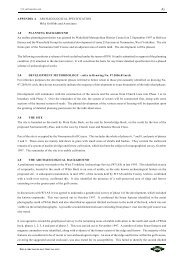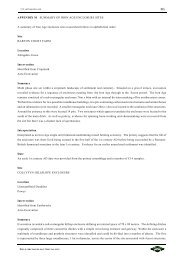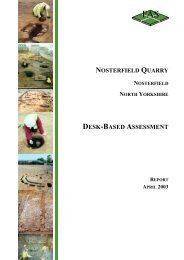ARCHAEOLOGICAL EVALUATION - Mike Griffiths and Associates
ARCHAEOLOGICAL EVALUATION - Mike Griffiths and Associates
ARCHAEOLOGICAL EVALUATION - Mike Griffiths and Associates
Create successful ePaper yourself
Turn your PDF publications into a flip-book with our unique Google optimized e-Paper software.
FAS_lbf01.wpd 71<br />
A systematic environmental sampling method was employed. Deposits which were clearly of a mixed or<br />
secondary origin such as make-up layers or deposits which displayed a high degree of residual or intrusive<br />
artefactual material were not the subject of environmental sampling unless a specific question relating to<br />
function or social status could be addressed. Where deposits were thought to be of primary origin <strong>and</strong> had<br />
potential to contain biological remains, an appropriate sampling regime was established.<br />
8.2 FIELDWORK RESULTS<br />
8.2.1 Intervention 7<br />
Intervention 7 was situated in Zone D, adjacent to the southern<br />
boundary of the site (see Figure 36). This machine excavated<br />
trench measured 100m x 4m, <strong>and</strong> was orientated north-south<br />
(Plate 6). The ground level within southern half of the trench<br />
area was fairly level at c.42.20m AOD, sloping down to<br />
c.41.70m AOD at the northern end. The dark yellowish-brown<br />
gravel <strong>and</strong> clayey silt ploughsoil (C1123) was found to be<br />
c.0.30m deep, revealing an orangish-brown, gravel <strong>and</strong> silt<br />
natural subsoil. Some b<strong>and</strong>ing in the subsoil was evident, with<br />
an area of predominately gravel at the southern end of the<br />
Plate 6 Intervention 7 looking south (scale<br />
2m)<br />
trench <strong>and</strong> a broad b<strong>and</strong> of slightly darker subsoil containing a lower proportion of gravel throughout the centre<br />
of the trench. The surface of the natural subsoil reflected the ground-level topography.<br />
Three features were defined within Intervention 7 (F1, F2, F3)(Figure 37). F1 was situated close to the centre<br />
of the trench, continuing beneath the western edge of excavation. This possibly sub-circular feature was welldefined<br />
in plan; the visible extent of F1 was excavated, revealing a shallow cut measuring min.0.30m x 0.45m,<br />
<strong>and</strong> 0.25m deep, with gently sloping edges <strong>and</strong> an irregular concave base (Figure 38). The feature contained<br />
a single backfill (C1111) of dark greyish-brown fine clayey-silt with frequent flecks of charcoal, lenses of dark<br />
grey clayey-silt, <strong>and</strong> moderate inclusions of gravel <strong>and</strong> pebbles. Late Neolithic Grooved Ware type pottery was<br />
recovered from C1111 (Appendix F). Assessment of the pottery identified the sherds as belonging to two,<br />
possibly three vessels, one plain vessel <strong>and</strong> one, perhaps two, thick walled vessels with grooved decoration. Six<br />
flakes of flint were also recovered during excavation (see Appendix B). A few grams of very abraded<br />
unidentifiable calcined bone was recovered from F1 <strong>and</strong> is likely to be burnt animal bone. The edges of F1<br />
revealed no evidence for in situ burning; the feature was therefore interpreted as a small pit containing flint<br />
debitage, broken pottery <strong>and</strong> ash. Environmental samples were retained from F1 to assess the potential of a<br />
well-dated Neolithic feature, <strong>and</strong> flotation recovered charcoal, sixty-three small pieces of knapping debris, <strong>and</strong><br />
a few pieces of undiagnostic calcined bone. The charcoal included small abraded fragments of hazelnut shell<br />
<strong>and</strong> occasional small fragments of oak <strong>and</strong> non-oak charcoal (Appendix G).<br />
The location of F1 within the long trench section provided a rare opportunity to examine the interface between<br />
ploughsoil <strong>and</strong> the remains of a Neolithic feature. F1 had clearly been plough-damaged, since the interface in<br />
section between ploughsoil <strong>and</strong> feature was extremely turbulent, with b<strong>and</strong>s of subsoil having been dragged<br />
across <strong>and</strong> redeposited into the feature by the plough (see Figure 38). In addition, some root disturbance was<br />
FIELD ARCHAEOLOGY SPECIALISTS







